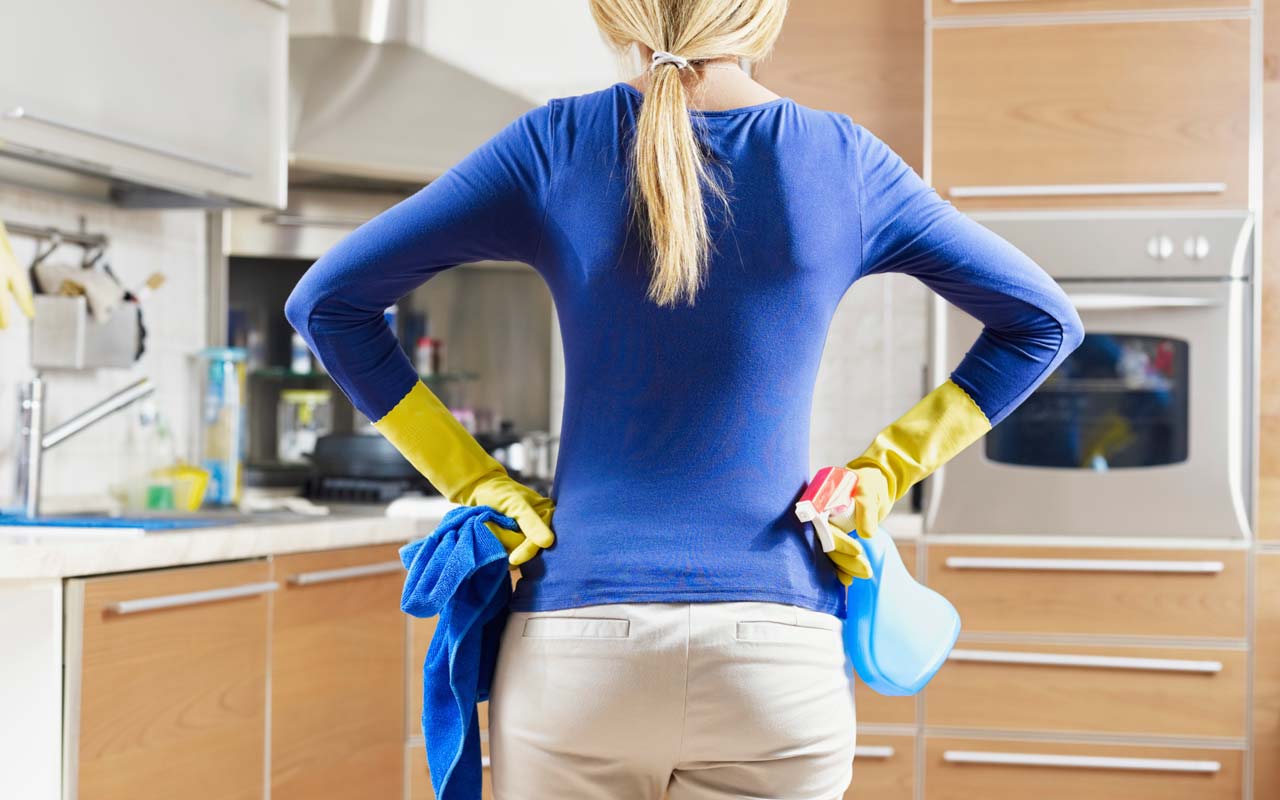A Complete Spring Home Maintenance Checklist for 2025
Use this 20-point checklist to get your home ready for spring.

Rachael Green
As you go about your annual spring cleaning ritual, it's a great time to knock out a few routine home maintenance tasks and take care of any small home improvements or repairs that have been nagging you for awhile.
Keeping up with home maintenance pays off in the long run in the form of lower energy bills and preventing big-ticket repairs later.
Here are 20 things for you (or the handyman) to tackle now to help prepare your home for the warmer months ahead and keep it in top shape.
As you go about your annual spring cleaning ritual, it's a great time to knock out a few routine home maintenance tasks and take care of any small home improvements or repairs that have been nagging you for awhile.
Keeping up with home maintenance pays off in the long run in the form of lower energy bills and preventing big-ticket repairs later.
Here are 20 things for you (or the handyman) to tackle now to help prepare your home for the warmer months ahead and keep it in top shape.
1. Inspect the AC, part 1
For about $75 to $200, a technician will tune up your cooling system to manufacturer-rated efficiency — and you won’t sweat the first hot weekend with an out-of-commission air conditioner.
Look for a heating and air conditioning contractor that belongs to the Air Conditioning Contractors of America, employs technicians certified by the North American Technician Excellence (NATE) program and follows the protocol for the ACCA's national standard for residential maintenance.
You can also call your electric utility to see whether it offers incentives like rebates or credit for keeping your HVAC system maintained.
Note: Dirty filters make your air conditioner work harder, increasing energy costs and possibly damaging your equipment. Check them monthly and clean or replace them as needed — or at least every three months.
2. Inspect the AC, part 2
Air conditioners draw moisture from interior air, called condensate, which must run off outside.
If sediment and algae clog the drains, water may back up, making your home more humid or creating water damage. Technicians will check the drains during a tune-up.
If you skip this year's tune-up and they have to come for an emergency clean-out, it could cost you up to $400.
If you live in a humid climate, you may want to check and clean the drains yourself periodically between tune-ups.
For an oddly riveting demonstration, watch this YouTube clip as the video's star suctions gobs of algae from a drain with a wet vac.
3. Put the temperature on autopilot
With an initial investment of $20 to $250 for a programmable thermostat, Energy Star says you can save about $100 annually on cooling and heating bills — if you can live with higher indoor temperatures in summer (and cooler temperatures in winter).
Set the "hold" or "vacation" feature for a constant, efficient temperature when you’re away for the weekend or on vacation. If you have a Wi-Fi-enabled version, reset the temperature from your smart phone.
In summer, you can make those settings more tolerable if you install ceiling fans. Just remember that a ceiling fan cools people, not a room, so turn it off when you leave the room.
4. Re-install AC window units
Before you heft units onto your window sills, check out this YouTube video for practical tips that will help you maximize energy efficiency — and keep out burglars and bugs, too.
Also, take a moment to clean the air conditioner. Remove the unit's front grill, then its air filter, and clean dust and dirt from the filter.
Check the filter monthly and clean it as needed throughout the cooling season.
5. Clean the swamp cooler
If you live in a hot, dry climate and cool your home with an evaporative, or "swamp" cooler, you must drain and clean the cooler seasonally to remove built-up sediment and minerals.
Energysavers.gov says that the more a cooler runs, the more maintenance it will need, requiring that you look at the pads, filters, reservoir and pump at least monthly.
Replace the pads at least twice during the cooling season, or as often as once a month during continuous operation.
For more information on evaporative coolers, especially tips for saving water when using it in drought conditions, visit www.h2ouse.org.
6. Caulk the cracks
If the gap around a door or window is wider than a nickel, you need to reapply exterior caulk, says Bill Richardson, past president of the American Society of Home Inspectors.
Check window-glazing putty, too, which seals glass into the window frame.
Add weatherstripping around doors, making sure that you can’t see any daylight from inside your home. You’ll save money on air conditioning and you won’t have to repeat this task in the fall.
7. Clean out the gutters
Nature's detritus — decomposed leaves, twigs, and spring petals and seeds (think maple-tree "helicopters") — may be worse in spring than in fall.
Gutter cleaning generally costs $100 to $250 for a 2,000-square-foot home (with about 180 linear feet of gutter).
Add extensions to downspouts to carry water at least three to four feet away from your home's foundation. You can use 4-inch corrugated plastic pipe (about $12 for 6 feet at homedepot.com) to redirect the water away from your home.
8. Repair your roof
An easy way to inspect the roof to find damaged, loose or missing shingles without risking life and limb is to use a pair of binoculars.
If need be, hire a handyman to repair a few shingles ($100 to $300 for asphalt shingles, according to homeguide.com).
If the damaged section is more extensive, you’ll need a roofer (who will typically charge $400 to $1,000 to replace a 10-by-10-square-foot area). Check and repair breaks in the flashing seals around vent stacks and chimneys, too.
If your home has a flat roof with a parapet (a short wall around the perimeter), look for wear and tear in the roof surface. Check the flashing that seals the joint between the parapet and roof.
Heavy snow can split the flashing, resulting in leaks. If you need repairs, look for a roofer at the Web site of the National Roofing Contractors Association.
Clean out any roof drains or scuppers (openings in the parapet that allow water to drain) to avoid ponding, which could damage your roof and cause leaks below.
A "roof repair" or "sewer and pipe cleaning" company can help.
9. Remove stains from your roof
If dark streaks and stains blight your roof, it has an algae problem. Moss is not only an aesthetic problem, but it can cause asphalt shingles to curl or lift and blow off in high winds.
You can get rid of both problems by using a garden sprayer to apply a 50/50 solution of water and bleach, which you rinse after 10 to 15 minutes.
Before you start, wet down or cover plants below. Don't scrub or pressure wash lest you damage shingles.
You can hire a professional roof cleaner for about 20 to 60 cents per square foot, according to homeadvisor.com Expect to pay an additional $0.15 per square foot for a steep roof.
Roof cleaning can also restore cedar-shake and tile roofs to their original brightness.
10. Pressure wash your home
Spring-clean your home's exterior to remove accumulated dirt, mold, stains and the like from the siding, deck, sidewalks, driveway and garage floor, fences, and lawn furniture.
You can buy a pressure washer from Home Depot for between $100 and $500 to have on hand. If you're not ready to buy, you can also rent a pressure washer for $90 a day or $40 for a four hour rental.
The average cost of a professional power washing is $200 to $400, according to Angi.com, depending on the amount and type of crud.
However, used incorrectly pressure washers can harm your home. Before you start see this advice from Tim Carter of Ask the Builder.
11. Wash the windows
It's only when the windows are clean and the spring sun shines in that you'll realize how dirty they were.
Before washing the glass, clean out the sills and window tracks with a soft brush or vacuum attachment.
Pour a small amount of water into the sill to ensure that weep holes, which drain rainwater to the exterior, aren't clogged up. If the water doesn't exit, use a piece of thin wire to gently clear the hole. Window washers may charge extra to do this.
If this task isn't on your DIY list, you'll generally pay $4 to $8 per pane for a pro to do the job. And don't forget the screens (50 cents to $5 per screen, depending on size). You may have to pay more for cleaning on a third or fourth story.
12. Repair sidewalks and driveways
Fix any breakdown in concrete or asphalt before it worsens. You can patch or fill surface cracks, chips or flaking in concrete yourself using cement-repair products, such as those made by Quikrete.
For deeper cracks, settling or sunken concrete, or frost heaves (when moisture beneath the concrete has frozen and jacked up the slab), call a pro, whether a handyman or a concrete contractor.
Asphalt is harder to work with, so call a pro for that, too. Look for a member of the National Asphalt Pavement Association or just search for "paving contractors" on Google.
To increase the longevity of your driveway, have asphalt resealed every two to five years, depending on climate and wear patterns. Concrete should be resealed every one to three years (you can probably do the concrete job yourself).
A sealing contractor may charge $400 to $800 to seal a typical 20x20 (2-car) driveway in good condition, according to homeguide.com.
13. Keep your basement dry
An informal survey of homeowners reveals that the vast majority would rather have multiple root canals than cope with a basement that periodically gets wet. Simple steps to prevent flooding are outlined in How Not to Get Soaked.
If you have a sump pump, spring is a good time to test it and make sure it’s operating properly..
If water seeps through the foundation walls (does your basement smell musty? are the walls stained?), the best solution is probably to excavate the exterior wall and apply a waterproofing sealant (about $30 per square foot of below-grade wall).
While you have the area excavated, install a wall and footing drainage system, says professional engineer Kenneth Fraine, of Leesburg, Va. According to Fraine, if your home is on a slope, an exterior drain pipe leading away from the foundation is better than a sump pump. "Gravity never fails," he says.
14. Reseal exterior woodwork
Resealing is always a good idea to protect the wood. Wood decks, fences, railings, trellises, pergolas, and other outdoor structures will last longer and stay in better condition if they’re stained or resealed every year or two.
But more important, before you invite the whole family over for a reunion, make sure your deck can handle the load.
The North American Deck and Railing Association says that deck components inevitably age, but that salt air can hasten deterioration and heavy snow can cause stress damage.
At a minimum, test several areas of the deck for decay, especially those that tend to stay damp. Two signs it's time to replace some boards: The wood is soft and spongy, and it doesn’t splinter if you poke it with an ice pick or screwdriver.
For a complete checklist, visit www.nadra.org, or find a home inspector at www.homeinspector.org.
15. Call a chimney sweep
At the end of the heating season you’ll have no problem getting an appointment. Look for chimney sweeps certified by the Chimney Safety Institute of America and ask for a "level 1 chimney inspection and sweeping."
The sweep will make sure that the chimney caps are in place and the damper is working properly. With a wood-burning fireplace, you can close the damper whenever the fireplace is not in use.
In summer, you’ll save energy and reduce unpleasant odors carried by the inflow of air and aggravated by humidity.
For the greatest energy savings, insert a fireplace "draft stopper" in the flue, preferably after you’ve had the chimney cleaned.
16. Prepare to mow
A dull lawn mower blade doesn't slice, but instead tears grass, leaving it vulnerable to disease, sun damage and insects.
A blade typically needs sharpening once or twice a year, or more often depending on how big your yard is, how frequently you mow and the type of grass you have, according to the University of Florida.
If it's gas powered, you should also tune up your lawn mower every three months or after every 25 hours of use to increase its efficiency and reduce polluting emissions. Follow the manufacturer's instructions to change the spark plug(s), oil and oil filter (or clean it).
A pro tune up will cost an average of $75, but you can do the job yourself for about $15 — the cost of oil and parts.
17. Reset your irrigation system
If you have an irrigation system, you may be overwatering (and wasting money on water bills) because the controller isn’t properly set for your yard’s needs or because of broken or leaky components.
A certified irrigation auditor (to find one visit www.irrigation.org) will charge from $150 to $300 for a visual assessment of your system. An in-depth audit (that tests water application) will run $400 to $700.
Before hiring anyone, call your water utility. Some may provide an audit for free.
For tips on getting an irrigation audit and other ways to use less water on your yard, see Tips for Watering Wiselyfrom the EPA's WaterSense program.
18. Clean the dryer vent
Even if you clean your clothes dryer's lint trap after every use, the vent still accumulates lint over time, like plaque in your arteries, says Richardson.
That's especially likely if snow covered the exterior backdraft damper for a while last winter.
A clogged vent can reduce your dryer’s efficiency and create a fire hazard. If you're up for doing it yourself, check out this how-to guide to dryer-vent cleaning from About.com.
19. Check for signs of termites
Spring is the season of growth and rejuvenation; unfortunately, it also marks the start of termite swarming season. If there’s a bunch of winged insects flying out of a hole in the woodwork, call a licensed professional pest control company.
Termite removal can cost anywhere from $70 to $1,700, according to Angi.com. Your final price will depend on the type of treatment, the size of the area treated, and the type and scope of the infestation. That doesn't include the cost of repairing any damaged structures the pests left behind.
Do a visual inspection of your home every spring. Look for crumbling wood or what appears to be sawdust near the base of the wood and on the floor and look for gaps between wooden joints or between boards.
Knock on the walls throughout your home and listen for hollow sounds in the wood. Look for mud tubes within walls, and also underneath the house, connecting the ground to the house. This is how they travel.
Lastly, inspect the garden beds along the walls of your house. If you've got mulch in those beds, keep it at least 12 inches away from your wall and make sure the mulch layer is thin enough that there's at least a six inch gap between the bottom of your siding and the top of your mulch.
Clearing away the mulch makes the area immediately around your home less appealing to termites, but also makes it easier to spot any of the mud tubes mentioned earlier before they make it to your siding.
20. Prevent mosquitoes
In recent years, we’ve become more aware of the potential danger mosquitos can pose to our health. West Nile virus and Zika virus are just the latest diseases caused by these winged pests.
The best way to prevent mosquitoes around your home is simply by getting rid of any standing water.
Starting in spring, walk around your property after every rain, looking for buckets, wheelbarrows, pots and anything else that might gather standing water and dump them.
Cleaning your gutters and inspecting your outdoor plumbing for leaks that create standing water can also help to reduce breeding grounds for mosquitos.
If you have bird baths, rain barrels or other structures that need to hold standing water, stock up on mosquito dunks (or another BTI-containing product).
These contain a species of bacteria that eats mosquito larvae, but is otherwise harmless to birds, plants, fish or anything else that might drink that water. Just toss a fresh chunk of the stuff into each source of standing water every 30 days.
Get Kiplinger Today newsletter — free
Profit and prosper with the best of Kiplinger's advice on investing, taxes, retirement, personal finance and much more. Delivered daily. Enter your email in the box and click Sign Me Up.

- Rachael GreenPersonal finance eCommerce writer
-
 How to Get Apple TV Plus for just $2.99
How to Get Apple TV Plus for just $2.99For a limited time, you can get three months of Apple TV Plus for just $2.99 per month. Here’s how to get the deal.
By Rachael Green Published
-
 Stock Market Today: Stocks Surge to Close a Volatile Week
Stock Market Today: Stocks Surge to Close a Volatile WeekIt was another day with a week's worth of both news and price action, but it ended on a strongly positive note.
By David Dittman Published
-
 How to Spot and Avoid Real Estate Scams in 2025
How to Spot and Avoid Real Estate Scams in 2025Learn how to recognize and prevent the latest real estate scams.
By Dori Zinn Published
-
 12 Great Places to Retire in the Midwest
12 Great Places to Retire in the MidwestPlaces to live Here are our retirement picks in the 12 midwestern states.
By Stacy Rapacon Published
-
 10 Cheapest Small Towns to Live In
10 Cheapest Small Towns to Live InThe cheapest small towns might not be for everyone, but their charms can make them the best places to live for plenty of folks.
By Dan Burrows Published
-
 Best Cold Weather Places to Retire
Best Cold Weather Places to RetirePlaces to live Some like it hot; others not so much. Here are the 12 best places to retire if you can't stand the heat.
By Stacy Rapacon Published
-
 The Cheapest Places To Retire in the US
The Cheapest Places To Retire in the USWhen you're trying to balance a fixed income with an enjoyable retirement, cost of living is a crucial factor to consider.
By Stacy Rapacon Published
-
 Remodeling Projects That Pay Off and Look Great
Remodeling Projects That Pay Off and Look GreatThese remodeling projects will give your home a fresh look — and they provide a decent return on investment, too.
By Robyn A. Friedman Last updated
-
 What Is a Triple Net Lease?
What Is a Triple Net Lease?What Is a Triple Net Lease?
By Erin Bendig Last updated
-
 The Six Best Places to Retire in New England
The Six Best Places to Retire in New Englandplaces to live Thinking about a move to New England for retirement? Here are the best places to land for quality of life, affordability and other criteria.
By Stacy Rapacon Last updated

